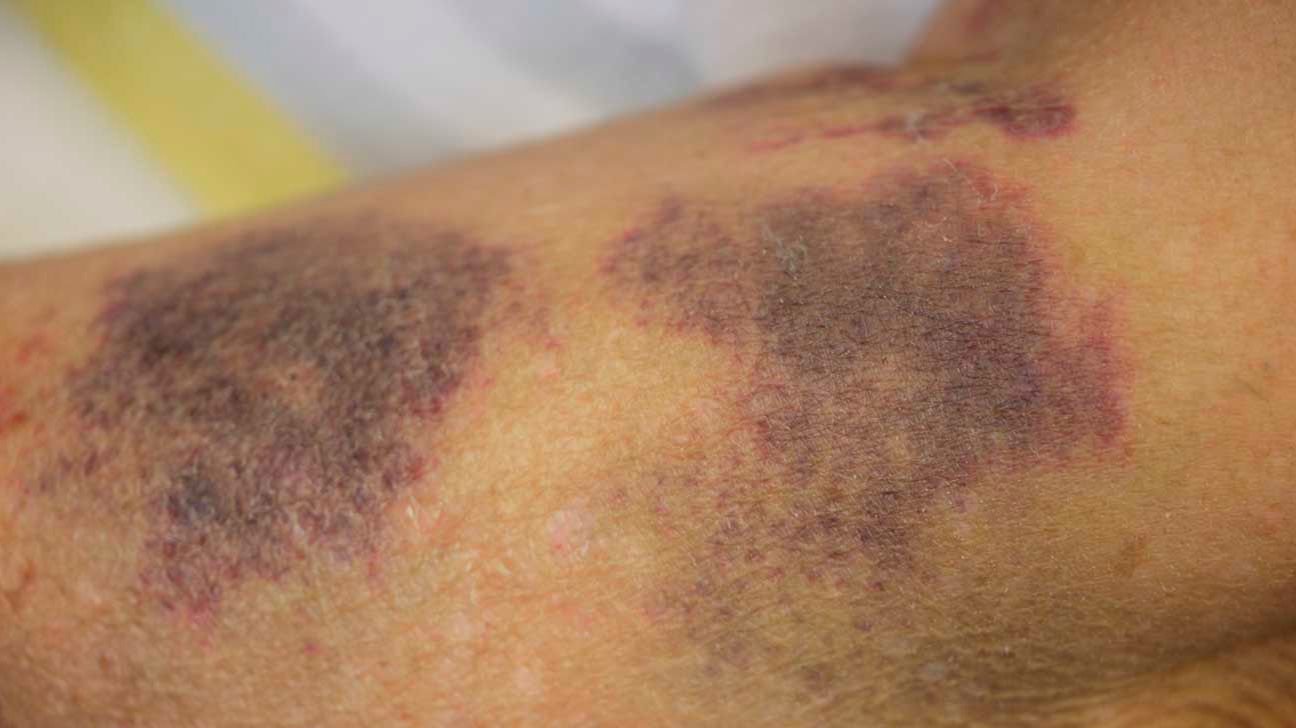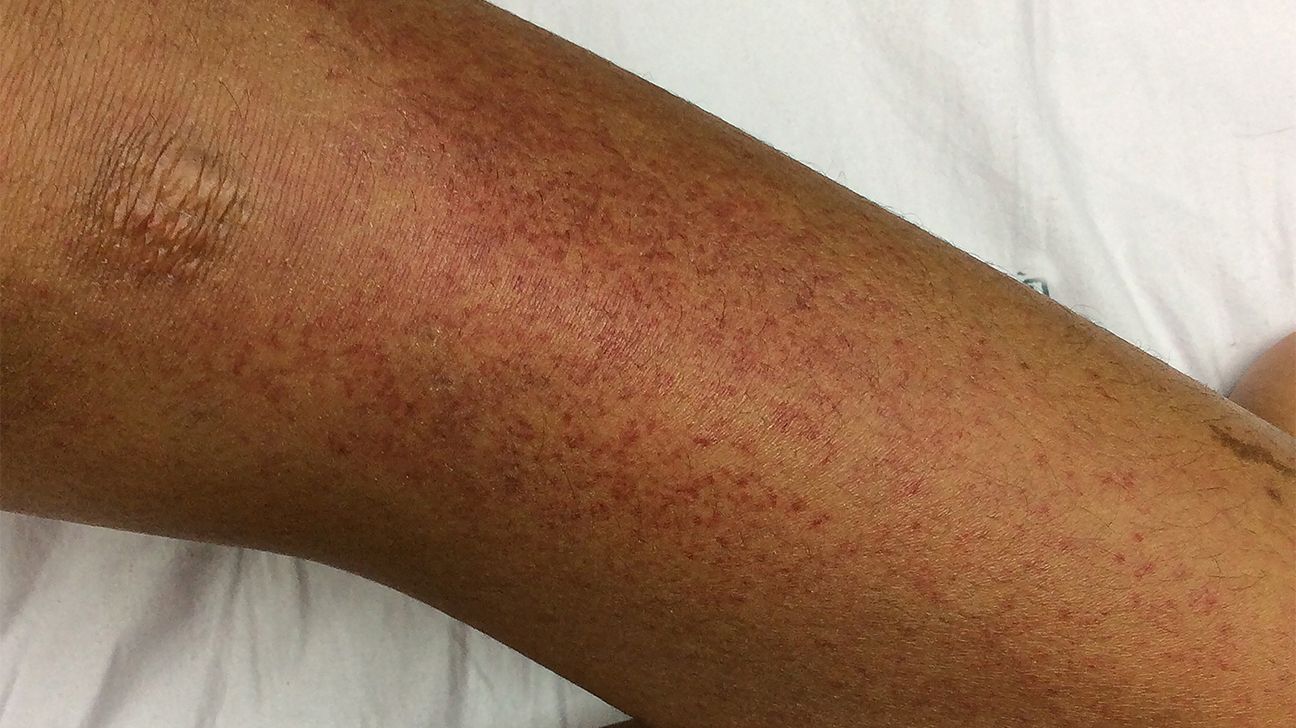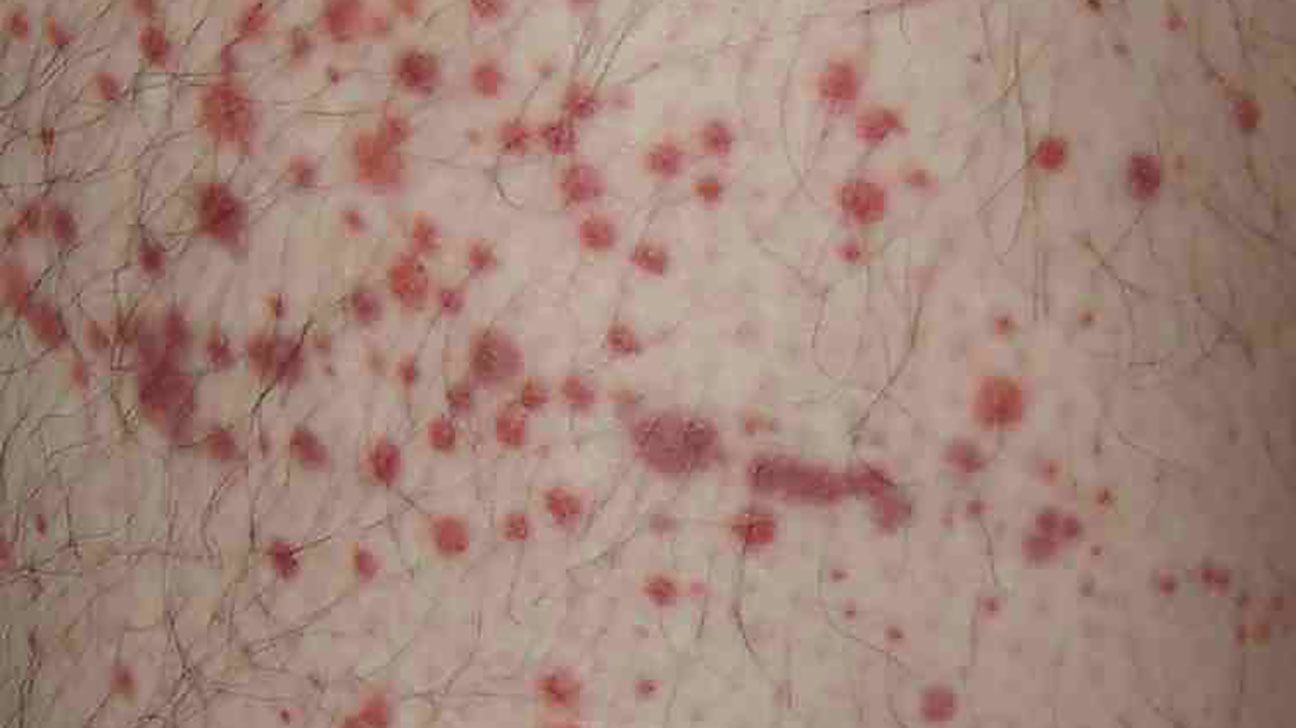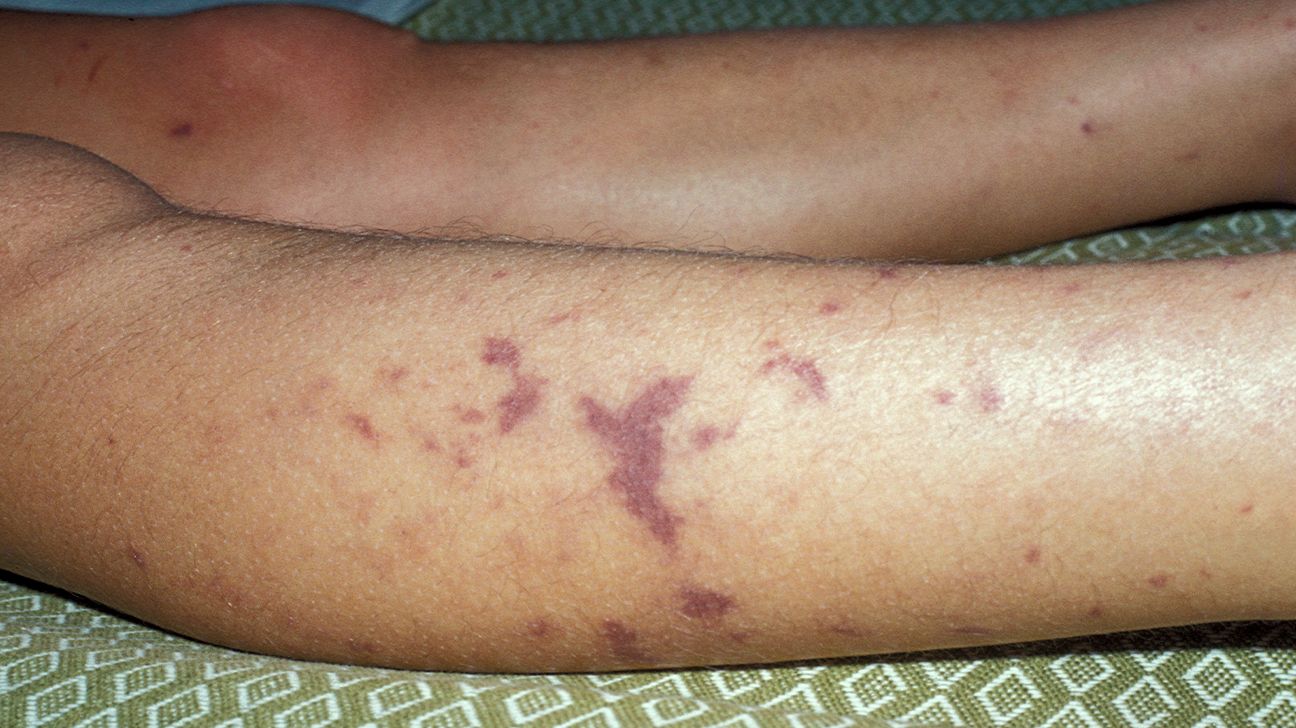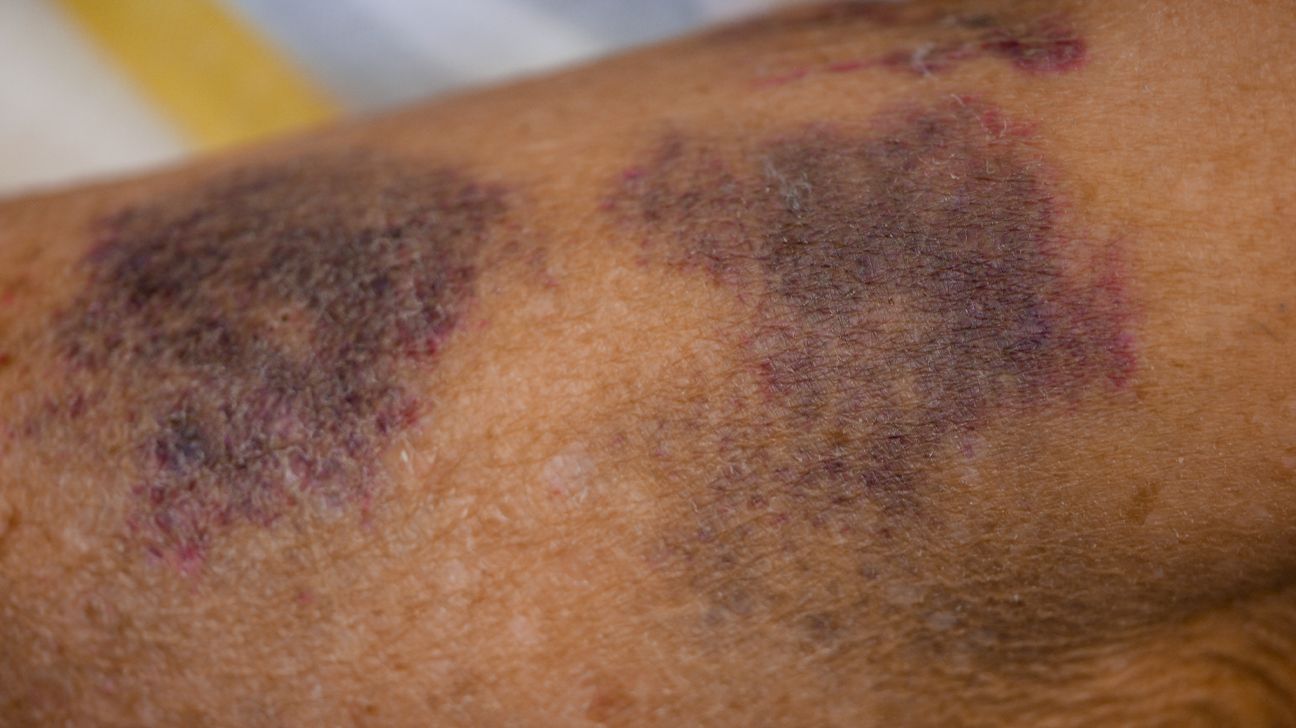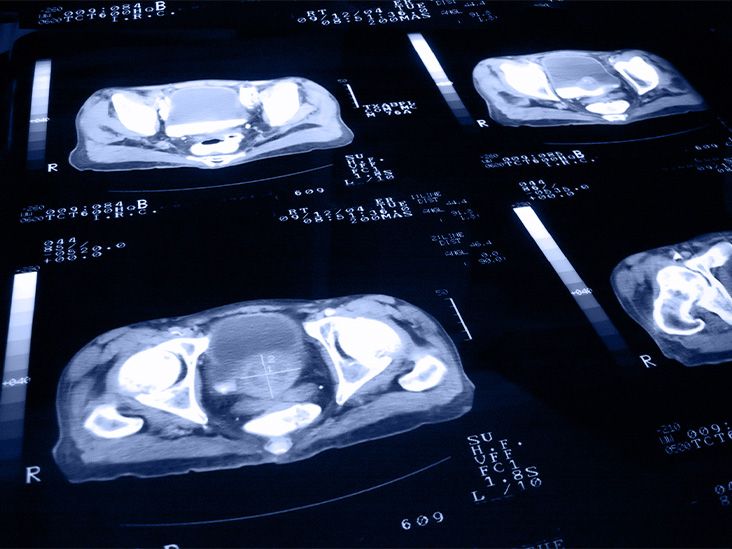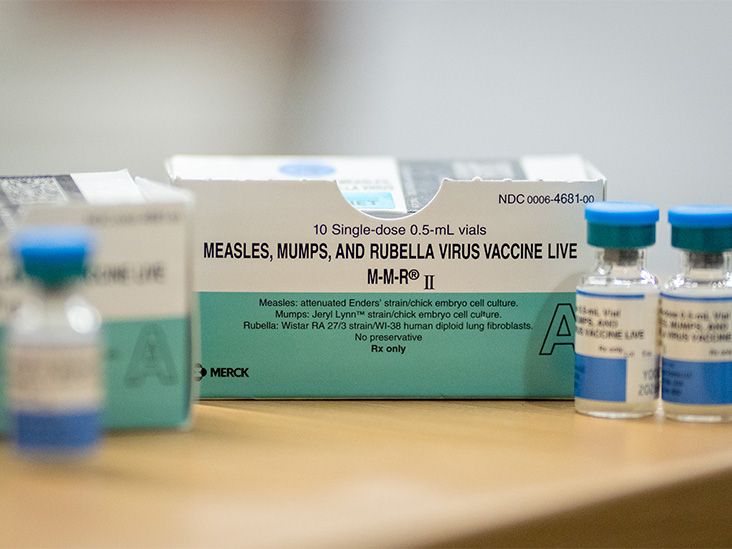A purpura rash occurs when small blood vessels burst, causing blood to pool under the skin. They appear as small, reddish-purple spots just beneath the skin’s surface.
Purpura, also known as skin hemorrhages or blood spots, can signal several medical problems, ranging from minor injuries to life threatening infections.
Purpura is a physical sign of an underlying disease, rather than a disease in itself, with many potential causes.
In this article, we will explain what purpura is, why it happens, its diagnosis, and treatment.
Doctors often break purpura rashes into two categories based on platelet counts. Platelets are cell fragments that help blood to clot more effectively, preventing dangerous bleeding.
Thrombocytopenic purpura
Thrombotic thrombocytopenic purpura (TTP) means that platelet counts are low, suggesting an underlying clotting disorder.
A low platelet count can cause excessive bleeding and bruising. Many factors can cause it, including:
- cancer
- bone marrow transplants
- HIV infections
- chemotherapy
- estrogen therapy
- hormone replacement therapy
- some medications
Nonthrombocytopenic purpura
Nonthrombocytopenic purpura happens when platelet levels are normal, suggesting another cause.
One of the most-studied varieties of purpura is Henoch-Schönlein purpura, a nonthrombocytopenic version of purpura. More common among young children, this type of purpura frequently precedes a respiratory infection.
Symptoms often go away on their own. However, some people with Henoch-Schönlein purpura experience dangerous inflammation that leads to kidney problems.
A range of underlying medical conditions can cause both kinds of purpura.
What is solar purpura?
Over time, reductions in subcutaneous fat and connective tissue and long-term sun exposure can lead to increased bruising of mature skin due to minor trauma. This is known as actinic purpura. Other names for this include solar purpura, senile purpura, traumatic purpura, and Bateman’s disease.
This type of purpura is more common in older adults, and risk increases with age, affecting
These patches of ruptured blood vessels can look dark purple or brown. However, they typically fade within 1–2 weeks. Some hyperpigmentation may remain after the purpura resolves.
No treatment is necessary for this type of purpura. However, a person can speak with their doctor or dermatologist about options for reducing or improving the appearance of these marks.
To treat purpura, doctors must determine its cause. Purpura that is not associated with lower platelet levels (nonthrombocytopenic purpura) has a range of causes and risk factors, including:
- disorders and infections that cause abnormalities in blood vessels or blood production
- amyloidosis, which causes amyloid plaques to build up in the body
- blood vessel deterioration associated with age
- a lack of vitamin C, also known as scurvy
- infectious or inflammatory diseases that affect the blood vessels
- some drugs, such as steroids and sulfonamides
- allergic purpura
Purpura with a lowered platelet count (thrombocytopenia) has several potential causes:
- drugs that reduce platelet count
- recent blood transfusions
- Rocky Mountain spotted fever
- systemic lupus erythema
- severe infections, including HIV and hepatitis C
ITP occurs when the body attacks its platelets, increasing the risk of bleeding and purpuric rashes. A low platelet count in newborns whose mothers have ITP can also lead to purpura.
Diseases that impair bone marrow function may restrict the body’s ability to make platelets, and attack bone marrow, such as:
Small purple spots on the skin, typically 4–10 millimeters (mm) in diameter, characterize purpura. Some people develop areas of spots
The main symptom of purpura is a purplish-red rash beneath the skin’s surface. This rash may appear dark brown or black on darker skin tones. The rash can appear anywhere on the body, including on mucous membranes such as the lining of the mouth.
The symptoms that sometimes accompany purpura can help identify its cause.
Purpura tends to occur in clusters found in a single area or covering a large portion of the body. The larger the rash is, the greater the bleeding will often be.
Unlike other rashes, purpura will not change color or blanch when pressed. The rash can resemble tiny clusters of bruises. While the skin will not be itchy or painful in many cases, some tenderness or irritation may sometimes occur.
Sometimes, the spots can appear on mucous membranes, for instance, inside the mouth.
Patients who experience purpura with any of the following symptoms should seek medical treatment:
- low platelet count, which may lead to increased bleeding after an injury, bleeding gums or nose, or blood in urine or bowel movements
- sore, swollen joints, particularly in the ankles and knees
- gut problems such as nausea, vomiting, diarrhea, or stomach pain
- kidney problems, particularly protein or blood in the urine
- excessive tiredness
The spots of purpura are fairly easy to tell apart from other rashes. Purpura may not occur with itching or skin symptoms. Finding the underlying cause of purpura can be tricky.
Doctors often ask questions such as:
- Do you have any other symptoms?
- Does anyone else in the home have the same symptoms?
- How long have you had the rash?
- Have you had this rash before?
- Do you take any medications?
- Are there any other medical problems?
Several routine tests, beginning with a complete blood count (CBC) blood test, help investigate the cause of purpura. A CBC will reveal whether the patient has low platelets and whether any underlying infections are occurring.
If the doctor suspects ITP, they may order additional testing. Certain clinical situations may call for bone marrow testing. A skin biopsy can also provide important information, particularly when a doctor cannot find an underlying cause for the purpura.
Some forms of skin cancer look similar to the purple spots of purpura. A biopsy can rule out skin cancer.
If a doctor suspects Henoch-Schönlein purpura, urine tests can assess kidney function by testing for protein and blood in the urine.
Doctors may also perform other tests based on the patient’s symptoms and the suspected diagnosis.
Not all cases of purpura demand immediate treatment. Doctors often opt to watch the patient for other symptoms to see if they go away on their own. Children experiencing Henoch-Schönlein purpura are often likely to get better without treatment.
When treatment is necessary, it is not due to the rash itself. Underlying causes, such as leukemia, need to be treated, as do complications, such as kidney failure.
Treatment for Henoch-Schönlein purpura
Treatment for Henoch-Schönlein purpura focuses on improving the symptoms.
In some cases, doctors recommend NSAIDs to reduce inflammation and pain. However, people with gastrointestinal or kidney issues should avoid these medications.
Steroid treatment can reduce kidney damage and abdominal pain. Doctors may prescribe drugs to suppress the immune system if kidney damage is severe.
Treatments vary depending on a person’s specific needs, so people should discuss all medications and treatments with a doctor.
Treatment for ITP
ITP symptoms
Lifestyle treatments can also help since drugs such as aspirin prevent platelets from aggregating and clotting.
Drugs that suppress the immune system, such as prednisone, may help elevate platelet levels. In patients with platelet counts that are low enough to be life threatening, doctors may offer immune globulin treatment.
There are also some
Treatment for other forms of purpura
Treatment for other forms of purpura centers around tackling the underlying cause, not the skin manifestation. This can include options such as chemotherapy, antiviral drugs, steroid medications, antibiotics, and surgery.
Corticosteroids
Corticosteroids can help increase platelet count by reducing the activity of the immune system. Typically, a person will use corticosteroids for
The side effects of using corticosteroids for an extended period include cataracts, bone loss, and weight gain.
Intravenous immunoglobulin
If the purpura causes significant bleeding, intravenous immunoglobulin can help increase platelet levels. This treatment is normally only effective in the short term. This medication can also help manage purpura in people who are resistant to corticosteroid therapies.
Side effects include nausea, fever, and headache.
Romiplostim (Nplate) and eltrombopag (Promacta)
These are the latest medications for the treatment of ITP. Both romiplostim (Nplate) and eltrombopag (Promacta) encourage the bone marrow to
Side effects include:
- dizziness
- headaches
- joint and muscle pain
- nausea
- vomiting
- increased blood clot risk
- acute respiratory distress syndrome
Rituximab (Rituxan)
Rituximab (Rituxan) helps lower the immune response. They predominantly treat thrombocytopenic purpura and patients who do not respond to corticosteroids. Side effects include sore throat, low blood pressure, fever, and rash.
When the cause of purpura is an incurable medical condition, checking platelet levels and organ functioning may be necessary.
Because purpura can signal an underlying medical problem, it may lead to complications without treatment.
When purpura results from a blood clotting condition, the untreated disorder can cause life threatening bleeding. Quick diagnosis and treatment of the underlying cause can reduce a patient’s risk of serious complications.
Kidney damage can occur in people with Henoch-Schönlein purpura; this damage may require dialysis or a kidney transplant and can become life threatening without treatment.
Henoch-Schönlein purpura may also cause a rare condition in which the bowel folds over itself; this creates a bowel obstruction that restricts digestion. Bowel obstructions can be fatal if left untreated.
ITP occasionally causes bleeding in the brain, causing permanent brain damage or death if not promptly treated.
Risk factors for purpura include:
- blood clotting issues caused by medication or disease
- infectious diseases, particularly among children and the elderly
- poor nutrition when it leads to a lack of vitamin C
- some forms of cancer, such as leukemia and myeloma
- inflammatory conditions and disorders, such as Ehlers-Danlos syndrome
- advanced age
- poor blood vessel health
Can you prevent purpura?
Purpura is not a disease but a physical sign of another problem. The only effective method for preventing purpura is avoiding the conditions that cause it. As most of these conditions are not due to lifestyle factors, a person can do little to reduce the risk of purpura.
What is the difference between purpura and petechiae?
Petechiae are pinpoint, non-blanching spots that are smaller versions of purpura. The cause of both is broken capillaries that leak blood beneath the skin. Purpura and petechiae both indicate an underlying health condition.
Purpura is a collection of small blood pools beneath the skin. These occur when blood vessels burst near the skin’s surface and may appear red, purple, or black. Purpura is a symptom and not a condition itself.
People may refer to these presentations as skin hemorrhages or blood spots. Purpura are often the result of minor injury and resolve independently. However, they can also signify severe medical conditions such as immune disorders and infections.

